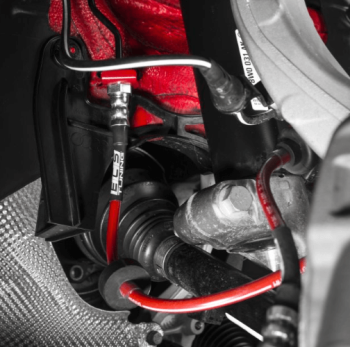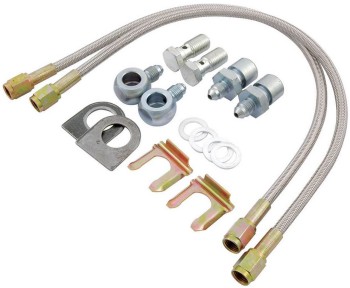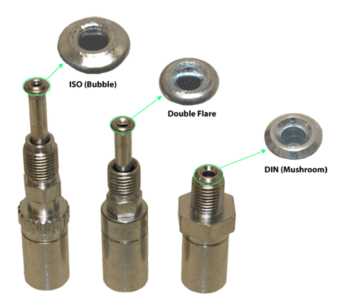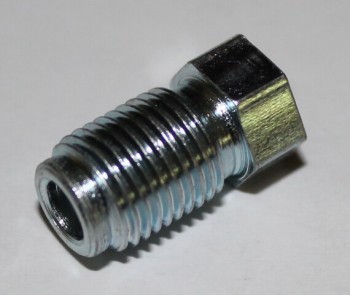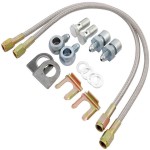While it may not be the most talked-about component in your braking system, your brake hose is still critical to your road safety and must be kept in check.
But what is a brake hose?
And how is it different from a brake line?
In this article, we’ll answer those questions and cover the different types of brake hoses used today. Then, we’ll describe three symptoms that highlight brake hose problems and let you know how often you’ll need a brake hose replacement.
What Is A Brake Hose?
A brake hose is a vital brake component responsible for delivering brake fluid from your vehicle’s master cylinder to the wheel cylinder (in drum brakes) or brake caliper (in disc brakes).
But wait.
Brake fluid is delivered through brake lines, right?
Yes.
So, does that mean a brake line and a brake hose are the same?
Not exactly.
They’re similar in that both the brake line and the brake hose act as conduits to transport brake fluid from the master cylinder.
However, they’re designed for different use cases.
How Is A Brake Hose Different From A Brake Line?
The brake line refers to the rigid metal tubing network that runs along the length of your car or truck. This tubing network channels brake fluid from the master cylinder to points near the wheels of your car, truck, or heavy-duty trailer.
But why does it stop there?
Why not go all the way to the wheel cylinder or brake caliper?
Because the metal tubing would break when your wheels turn sideways or when your car moves up and down as you drive over a speed bump.
It’s here that a hydraulic brake hose comes in handy.
Your brake hose is a flexible pipe that serves as a link between your rigid brake line and the brake caliper or wheel cylinder. Since the brake hose is flexible, it can adjust to your wheel movements without trouble.
Now, if brake lines are usually made of metallic tubing, what are brake hoses made of?
What Are The Different Types Of Brake Hoses?
You’ll generally come across two types of hoses:
1. Rubber Brake Hoses
A rubber brake hose (the most common type) is made from flexible rubber.
Sometimes, it also comes layered with fabric netting for extra protection.
Rubber hoses provide good braking performance, operate in a wide temperature and hydraulic pressure range, and cost less than the stainless steel option.
However, a significant disadvantage with this type of hose is that its surface will start to age and develop cracks with prolonged use. After a point, the structural integrity of your rubber hoses will decrease, causing it to leak brake fluid.
2. Stainless Steel Brake Hoses
Stainless steel brake hoses have sheaths made of stainless steel on the outside.
These hoses are more durable and rigid compared to rubber hoses. Moreover, since their sheaths are made of metal, stainless steel hoses are less prone to physical damage from abrasion and environmental elements.
However, they’re more expensive than rubber brake hoses.
In any case, irrespective of whether you use rubber hoses or stainless steel hoses, remember that the brake hose is critical to your vehicle’s safety.
And if you notice any brake hose issues, approach a professional mechanic ASAP to diagnose your brake system and check whether you need a new brake hose installation.
But what “issues” are we talking about here?
When Do You Need A New Brake Hose?
Your hydraulic brake hose doesn’t last forever.
And that’s why it’s essential to pay attention to the effectiveness of your brake hose assembly.
Just watch out for these three common symptoms of a defective brake hose:
1. Soft Brake Pedal
If your brake pedal feels unusually soft or mushy as you depress the brake pedal, your brake hose assembly may already be damaged.
Why?
A defective brake hose can cause the brake fluid it transports to leak out.
As a result, the brake fluid level drops, and the hydraulic pressure your brakes can transmit plunges.
In turn, the stopping power of your vehicle goes down, and the brake pedal will feel soft.
2. Worn-Out Brake Hose
Your brake hoses can develop cracks, degrade, and wear out over time.
But why?
Brake hoses are constantly exposed to environmental elements and are subjected to flexing, turning, braking, high hydraulic pressure, and abrasion. Together, these factors wear down your hoses.
Worn-out brake hoses are more likely to leak brake fluid, and if unchecked, this can lead to total brake system failure.
A simple visual inspection can reveal if your brake hose assembly is at its limits. However, if you’re inexperienced with vehicle repairs, you won’t know what to look for during the inspection.
It’s best to leave the inspection of brake hose conditions to a professional mechanic who will then carefully search for:
- Cracks
- Bulges
- Tears
- Loose hanging threads
- And more
And, in case of excessive wear, the mechanic might recommend a brake hose replacement.
3. Inoperable Brakes
Sometimes, your brakes stop working entirely.
It’s important to note that an abrupt, total failure of a brake system is rare.
Usually, there’ll be early warning signs of bad brake hose conditions like a soft pedal, brake fluid puddles, or corrosion of the end fittings of your brake hose.
However, if a brake hose gets completely severed for some reason, the link to a wheel cylinder or caliper would be gone. And when that happens, the safety of your car or truck is at risk.
Bear in mind that inoperable brakes can also result from a damaged brake line, vacuum brake booster, brake caliper, or other brake parts.
In any case, if your brakes fail, request a professional mechanic’s help immediately.
Now that you know what symptoms indicate a defective brake hose let’s see how often you might need to get new hoses.
How Often Should You Replace Your Brake Hose?
Most professional mechanics would agree that a rubber brake hose can last about six years. On the flip side, stainless steel hoses can last between five and ten years or even longer.
Remember that there’s no hard-and-fast rule to predict how long a hydraulic hose will last since brake hose conditions vary across brake assemblies in different vehicles.
That’s because, apart from the material used to build your brake hose, several factors influence your brake hose’s lifetime, for example:
- Manufacturing quality
- Driving habits
- Road conditions
- Type of vehicle: light (like a car) or heavy duty (like a trailer truck)
- And more
And when your hydraulic brake hose fails, you’ll need a new one.
But how do you choose a suitable hydraulic hose for your vehicle?
What To Look For When Buying A New Brake Hose
When purchasing new brake hoses, keep these five tips in mind:
1. Choose OEM brake hoses or ones from reputable brands. Remember that the brake hose, like other brake parts, is crucial to road safety. So, you need a quality product.
2. Ensure that the brake hose comes with end fittings that are resistant to corrosion. Otherwise, the end fittings that link with the brake line can fall prey to corrosion and start to degrade, causing the brake fluid to leak out.
3. Confirm that the hydraulic hose is dry-rot resistant — dry rot is when the brake hose surface decays with exposure to environmental conditions and begins to develop cracks or become flaky.
4. Don’t overpay for a brake bose and its installation. To give you an idea, the purchase and installation of a new brake hose will usually cost between $150 and $360. But remember that this figure will vary based on the location you’re at.
5. Finally, ask about the expected lifespan of the brake hose and its warranty terms & conditions.
Closing Thoughts
Your hydraulic brake hose is critical to proper brake system functioning and road safety.
Watch out for any symptoms that could indicate a potential brake hose failure. And if you do notice any issues, get in touch with a mechanic ASAP.

